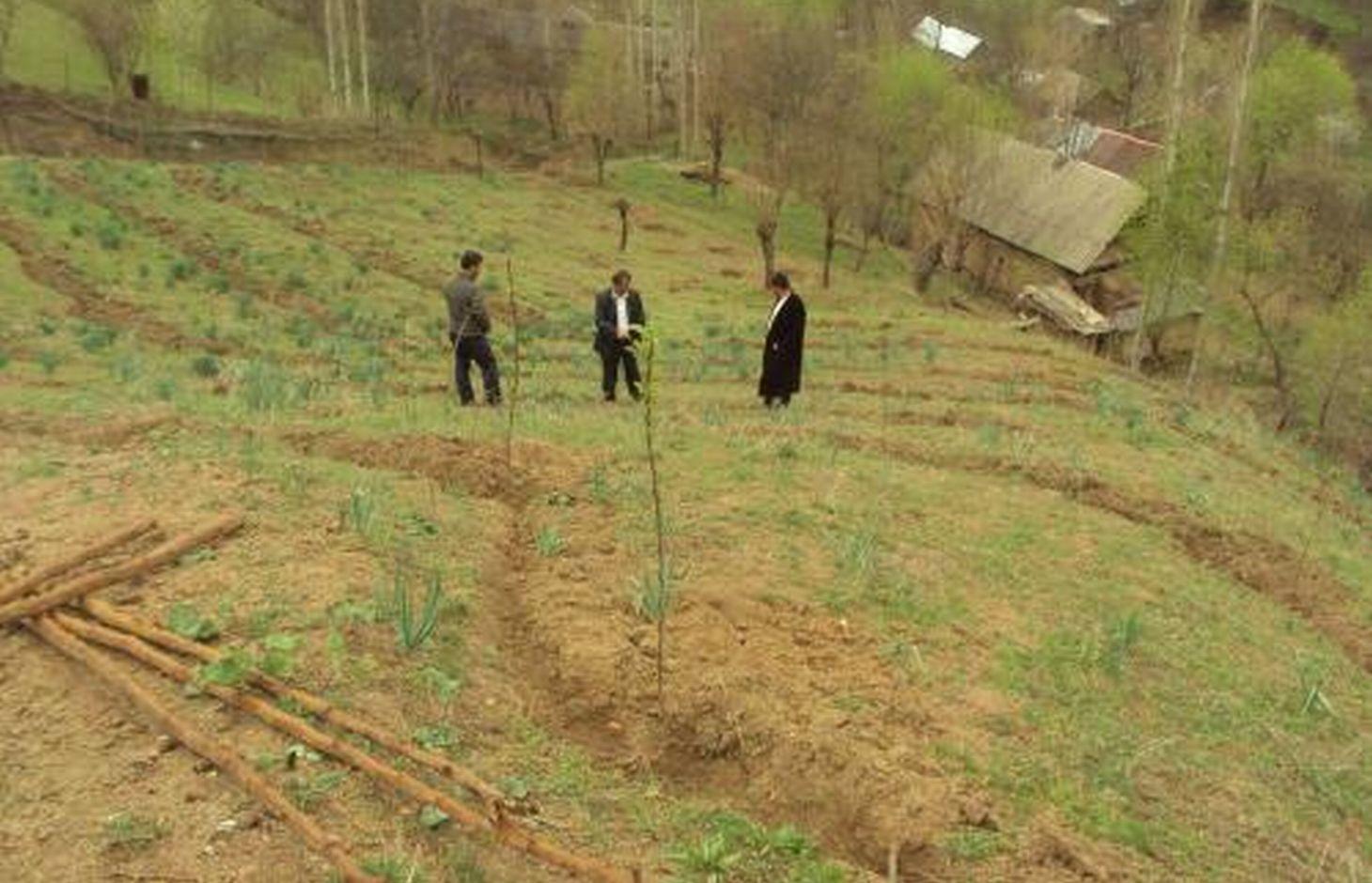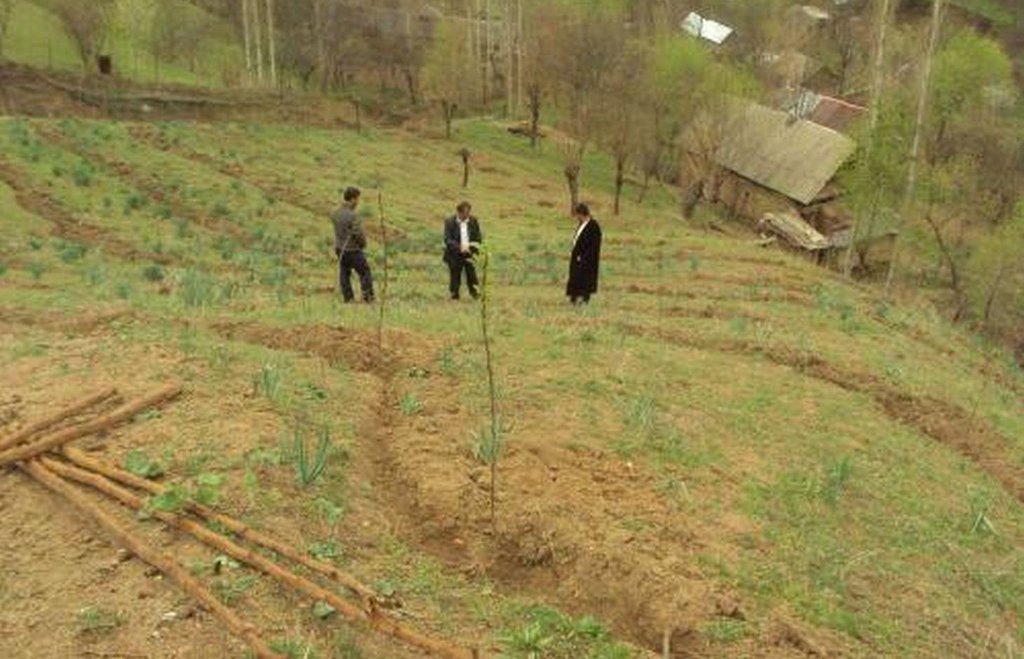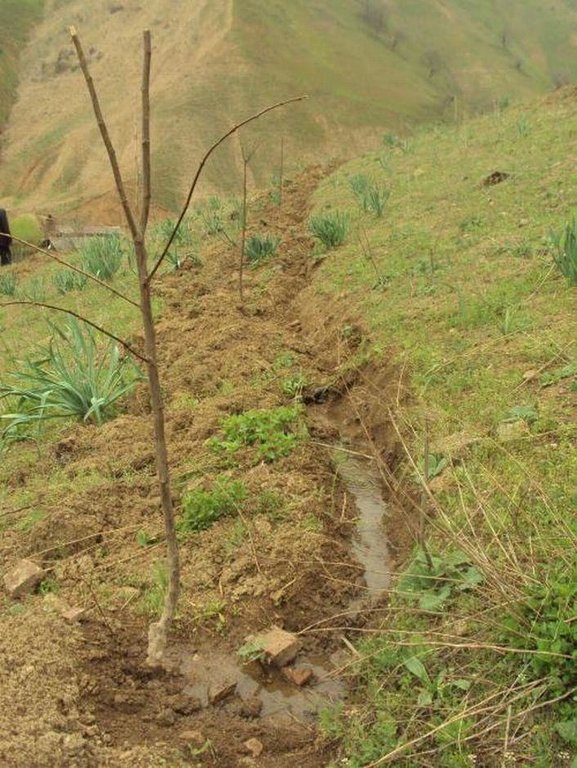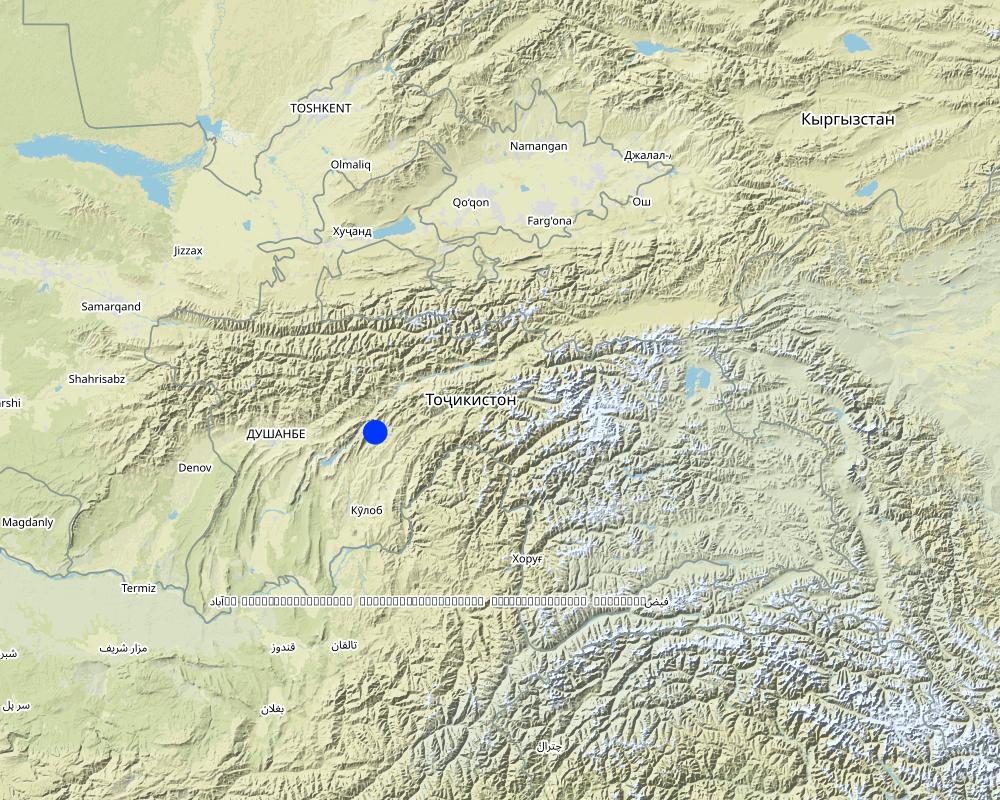Planting of fruit trees to increase slope stabilisation [Tajikistan]
- Creation:
- Update:
- Compiler: Gulniso Nekushoeva
- Editor: –
- Reviewers: David Streiff, Alexandra Gavilano, Joana Eichenberger
Табдил додани чарохгох ба бог
technologies_1520 - Tajikistan
- Full summary as PDF
- Full summary as PDF for print
- Full summary in the browser
- Full summary (unformatted)
- Planting of fruit trees to increase slope stabilisation: Aug. 20, 2019 (inactive)
- Planting of fruit trees to increase slope stabilisation: Nov. 2, 2021 (public)
- Planting of fruit trees to increase slope stabilisation: Julie 20, 2017 (inactive)
- Planting of fruit trees to increase slope stabilisation: Julie 22, 2017 (inactive)
- Planting of fruit trees to increase slope stabilisation: Maart 15, 2017 (inactive)
View sections
Expand all Collapse all1. General information
1.2 Contact details of resource persons and institutions involved in the assessment and documentation of the Technology
SLM specialist:
SLM specialist:
Name of project which facilitated the documentation/ evaluation of the Technology (if relevant)
Pilot Program for Climate Resilience, Tajikistan (WB / PPCR)Name of the institution(s) which facilitated the documentation/ evaluation of the Technology (if relevant)
NCCR North-South (NCCR North-South) - KyrgyzstanName of the institution(s) which facilitated the documentation/ evaluation of the Technology (if relevant)
Tajik Academy of Agricultural Sciences (Tajik Academy of Agricultural Sciences) - TajikistanName of the institution(s) which facilitated the documentation/ evaluation of the Technology (if relevant)
Tajik Soil Insitute (Tajik Soil Institute) - TajikistanName of the institution(s) which facilitated the documentation/ evaluation of the Technology (if relevant)
CAMP - Central Asian Mountain Partnership (CAMP - Central Asian Mountain Partnership) - Kyrgyzstan1.3 Conditions regarding the use of data documented through WOCAT
The compiler and key resource person(s) accept the conditions regarding the use of data documented through WOCAT:
Ja
1.5 Reference to Questionnaire(s) on SLM Approaches (documented using WOCAT)
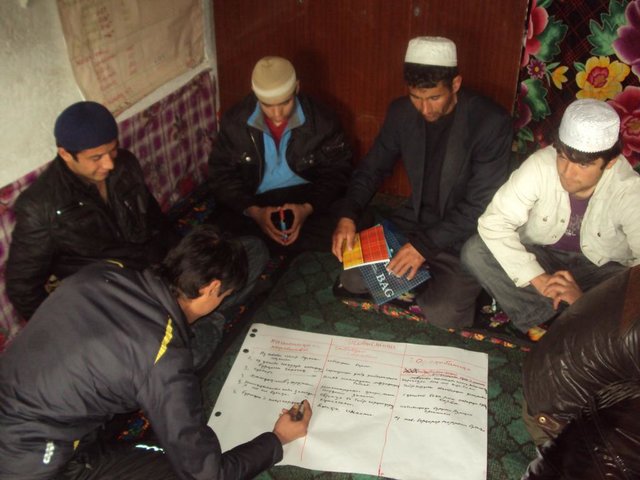
Selection of SLM Technologies for Natural Disaster Risk … [Tajikistan]
Community Based Natural Disaster Risk Management Workshops for identification of locations for the implementation of SLM technology to reduce the risk to the village from natural disasters.
- Compiler: shane stevenson
2. Description of the SLM Technology
2.1 Short description of the Technology
Definition of the Technology:
Planting fruit tree orchards to increase the stability of the steep loess soil slopes.
2.2 Detailed description of the Technology
Description:
This technology involved the planting of several varieties of native fruit trees to help stabilise steep loess mountain slopes. Seven species of fruit trees were planted in seven different locations, in two watersheds within the district of Nurobod in Tajikistan. The locations were chosen as a result of a natural disaster workshop that identified the areas most susceptible to landslides.
In consultation with the Institute of Horticulture a fruit tree planting scheme was devised and using project money the identified area was enclosed with a wire perimeter fence. The fruit trees were planted along irrigation contours running at shallow angles parallel to the slope.
Purpose of the Technology: The best locations for planting the fruit trees were decided on via a participatory community workshop on natural disaster risk management.
During the workshop the community identified areas around the village that were considered high risk. A fruit tree planting scheme was implemented in these areas to help stabilise the slopes, reduce surface water run off and top soil erosion, and reduce the risk of landslides. As the trees grew they were intercropped with wheat and espercet.
Establishment / maintenance activities and inputs: Several 'at risk' areas were identifed within these workshops, therefore the project team had to assess the areas for suitability. Two of the main criteria used included the access to water and if there was sufficient depth of top soil to sustain a fruit orchard.
Once the area was decided upon, a Memorandum of Understanding (MoU) was signed with the particular land user. It was made clear to the community that the land was chosen based upon the decisions from the workshop and not because of any form of favouritism towards the land user. The MoU stated that the land user was responsible for the planting and maintenance of the orchards.
The Horticultural Institute devised a planting a scheme based upon the loaction and soil type. The implementation activities occurred in early spring. A continuos wire fence was erected around the area, and the fruit trees were planted at five metre intervals along a dug contour irrigation ditch. One kilo of organic fertiliser was applied to each tree and later in the season they were sprayed with pesticides.
Natural / human environment: Nurobod district is a mountainous area, with large tributaries flowing into the Vasht river. There are mass erosion processes at work, causing gullies and washing away the top soil. The previous civil war, compounded by harsh winters resulted in extensive clearance of the surrounding vegetation for fuel. These areas have became further degraded by over grazing on the remaining grass lands.
The local population suffers from high levels of labour migration of young men to Russia and resulting in a drain of knowledge and able bodied workers. This leaves the remaining families particulary vulnerable in this specific climate.
2.3 Photos of the Technology
2.5 Country/ region/ locations where the Technology has been applied and which are covered by this assessment
Country:
Tajikistan
Region/ State/ Province:
Tajikistan
Further specification of location:
Nurobod
Specify the spread of the Technology:
- evenly spread over an area
If precise area is not known, indicate approximate area covered:
- < 0.1 km2 (10 ha)
Comments:
Total area covered by the SLM Technology is 0.1 m2.
The SLM technology was implemented in 7 different locations covering 5 villages within the Mujiharf and Hakimi jamoats of Nurobod District. The two main watersheds are shown in the googleEarth file. The plot sizes varied between 0.5 - 1 H.a.
Map
×2.6 Date of implementation
If precise year is not known, indicate approximate date:
- less than 10 years ago (recently)
2.7 Introduction of the Technology
Specify how the Technology was introduced:
- through projects/ external interventions
Comments (type of project, etc.):
The project was implemented in 2010.
3. Classification of the SLM Technology
3.1 Main purpose(s) of the Technology
- reduce, prevent, restore land degradation
- reduce risk of disasters
3.2 Current land use type(s) where the Technology is applied

Cropland
- Annual cropping
- Tree and shrub cropping
Annual cropping - Specify crops:
- cereals - wheat (spring)
- espercet
Tree and shrub cropping - Specify crops:
- fruits, other
- stone fruits (peach, apricot, cherry, plum, etc)
- tree nuts (brazil nuts, pistachio, walnuts, almonds, etc.)
- pome fruits (apples, pears, quinces, etc.)
Is intercropping practiced?
Ja
If yes, specify which crops are intercropped:
wheat and espercet

Grazing land
Extensive grazing:
- Ranching
Animal type:
- goats
- cattle - dairy
- sheep
- Livestock density (if relevant): 1-10 LU /km2
Comments:
Major land use problems (compiler’s opinion): The steep loess slopes are devoid of vegetation, therefore the land is prone to washing away of top soil, gulley formation, and potential landslides.
Major land use problems (land users’ perception): The land has become unuseable, it was used as pasture land but every year it seems to be getting worse.
Ranching: cows, sheep and goats
Future (final) land use (after implementation of SLM Technology): Forests / woodlands: Fp: Plantations, afforestations
3.3 Has land use changed due to the implementation of the Technology?
Has land use changed due to the implementation of the Technology?
- Yes (Please fill out the questions below with regard to the land use before implementation of the Technology)

Grazing land

Forest/ woodlands
- Tree plantation, afforestation
Comments:
Future (final) land use (after implementation of SLM Technology): Forests / woodlands: Fp: Plantations, afforestations
Grazing land: Ge: Extensive grazing land
3.4 Water supply
Water supply for the land on which the Technology is applied:
- mixed rainfed-irrigated
Comments:
Number of growing seasons per year:
1
Specify:
Longest growing period in days: 200Longest growing period from month to month: March - October
3.5 SLM group to which the Technology belongs
- cross-slope measure
3.6 SLM measures comprising the Technology

vegetative measures
- V1: Tree and shrub cover
Comments:
Main measures: vegetative measures
Type of vegetative measures: aligned: -contour
3.7 Main types of land degradation addressed by the Technology

soil erosion by water
- Wt: loss of topsoil/ surface erosion
- Wg: gully erosion/ gullying
- Wm: mass movements/ landslides

biological degradation
- Bc: reduction of vegetation cover
Comments:
Main type of degradation addressed: Wt: loss of topsoil / surface erosion, Wg: gully erosion / gullying, Wm: mass movements / landslides
Secondary types of degradation addressed: Bc: reduction of vegetation cover
Main causes of degradation: deforestation / removal of natural vegetation (incl. forest fires) (Any shrubs and bushes previously on the land were removed.), over-exploitation of vegetation for domestic use (Shrubs and bushes were removed as fodder and for fuel purposes.), war and conflicts (Natural resources became increasingly valuable during the civil war of the 1990's.)
Secondary causes of degradation: overgrazing (Once the bushes were removed the area was used for grazing.), Heavy / extreme rainfall (intensity/amounts) (Heavy rainfall events have contributed to the degradation of the land.)
3.8 Prevention, reduction, or restoration of land degradation
Specify the goal of the Technology with regard to land degradation:
- reduce land degradation
- restore/ rehabilitate severely degraded land
Comments:
Secondary goals: prevention of land degradation
4. Technical specifications, implementation activities, inputs, and costs
4.1 Technical drawing of the Technology
Technical specifications (related to technical drawing):
The drawing shows a perimeter fence enclosing terraces of fruit trees. The trees are irrigated through a contour trench running at a shallow angle perpendicular to the slope. The land users have taken the opportunity to optimise the cultivated land by planting perennial and wheat crops between the rows of trees.
Location: Mujiharf. Nurobod, tajikisatn
Date: 22nd June 2011
Technical knowledge required for field staff / advisors: low (The technology is relatively straight forward and easy to implement.)
Technical knowledge required for land users: low (The land user is responsible for the continued maintenance of the fruit trees.)
Main technical functions: improvement of ground cover
Secondary technical functions: control of dispersed runoff: retain / trap, control of dispersed runoff: impede / retard, spatial arrangement and diversification of land use
Aligned: -contour
Vegetative material: F : fruit trees / shrubs
Number of plants per (ha): 400
Vertical interval between rows / strips / blocks (m): 5
Spacing between rows / strips / blocks (m): 5
Vertical interval within rows / strips / blocks (m): 5
Width within rows / strips / blocks (m): 5
Fruit trees / shrubs species: Cherry, Apple, Quince, Pear, Plum, Peach, Walnut
Slope (which determines the spacing indicated above): 25.00%
Gradient along the rows / strips: 2.00%
Author:
Pjotr M. Sosin, Camp Kuhiston, Dusahnbe
4.2 General information regarding the calculation of inputs and costs
other/ national currency (specify):
somoni
If relevant, indicate exchange rate from USD to local currency (e.g. 1 USD = 79.9 Brazilian Real): 1 USD =:
4.5
Indicate average wage cost of hired labour per day:
25.00
4.3 Establishment activities
| Activity | Timing (season) | |
|---|---|---|
| 1. | Erection of Fence | Spring - end of march |
| 2. | Planting of fruit trees. | March / April |
4.4 Costs and inputs needed for establishment
| Specify input | Unit | Quantity | Costs per Unit | Total costs per input | % of costs borne by land users | |
|---|---|---|---|---|---|---|
| Labour | Building fence | Persons/day | 28.0 | 25.0 | 700.0 | 100.0 |
| Labour | Planting fruit trees | Persons/day | 40.0 | 25.0 | 1000.0 | 100.0 |
| Equipment | Tools | Pieces | 6.0 | 20.0 | 120.0 | |
| Plant material | Seedlimgs | pieces | 400.0 | 8.0 | 3200.0 | |
| Fertilizers and biocides | Compost/manure | tons | 1.0 | 225.0 | 225.0 | 100.0 |
| Fertilizers and biocides | 1.0 | |||||
| Construction material | Metal fence and posts | meter | 400.0 | 12.0 | 4800.0 | |
| Total costs for establishment of the Technology | 10045.0 | |||||
| Total costs for establishment of the Technology in USD | 2232.22 | |||||
If land user bore less than 100% of costs, indicate who covered the remaining costs:
Horticulture Institue
Comments:
Duration of establishment phase: 2 month(s)
Costs are per h.a.
4.5 Maintenance/ recurrent activities
| Activity | Timing/ frequency | |
|---|---|---|
| 1. | pruning and tree care | Annually |
4.6 Costs and inputs needed for maintenance/ recurrent activities (per year)
| Specify input | Unit | Quantity | Costs per Unit | Total costs per input | % of costs borne by land users | |
|---|---|---|---|---|---|---|
| Labour | Prunning and tree care | Persons/day | 15.0 | 16.6666667 | 250.0 | 100.0 |
| Total costs for maintenance of the Technology | 250.0 | |||||
| Total costs for maintenance of the Technology in USD | 55.56 | |||||
Comments:
Machinery/ tools: spades, picks
The costs were calculated at 2010 prices for 400 trees planted over 1 h.a.
4.7 Most important factors affecting the costs
Describe the most determinate factors affecting the costs:
The main issue was the procurement of the fruit trees from a reliable credible source. Since the start of the project, land users purchased trees from local tree nurseries but the trees were of poor quality and some already had signs of disease. The scarity of natural resources, and the lack of controlled grazing means that wire fencing had to be used, This could only be purchased outside of the district and thus incurred high transport costs.
5. Natural and human environment
5.1 Climate
Annual rainfall
- < 250 mm
- 251-500 mm
- 501-750 mm
- 751-1,000 mm
- 1,001-1,500 mm
- 1,501-2,000 mm
- 2,001-3,000 mm
- 3,001-4,000 mm
- > 4,000 mm
Agro-climatic zone
- semi-arid
Thermal climate class: temperate
5.2 Topography
Slopes on average:
- flat (0-2%)
- gentle (3-5%)
- moderate (6-10%)
- rolling (11-15%)
- hilly (16-30%)
- steep (31-60%)
- very steep (>60%)
Landforms:
- plateau/plains
- ridges
- mountain slopes
- hill slopes
- footslopes
- valley floors
Altitudinal zone:
- 0-100 m a.s.l.
- 101-500 m a.s.l.
- 501-1,000 m a.s.l.
- 1,001-1,500 m a.s.l.
- 1,501-2,000 m a.s.l.
- 2,001-2,500 m a.s.l.
- 2,501-3,000 m a.s.l.
- 3,001-4,000 m a.s.l.
- > 4,000 m a.s.l.
Comments and further specifications on topography:
Altitudinal zone: For the seven plots.
5.3 Soils
Soil depth on average:
- very shallow (0-20 cm)
- shallow (21-50 cm)
- moderately deep (51-80 cm)
- deep (81-120 cm)
- very deep (> 120 cm)
Soil texture (topsoil):
- medium (loamy, silty)
Topsoil organic matter:
- medium (1-3%)
If available, attach full soil description or specify the available information, e.g. soil type, soil PH/ acidity, Cation Exchange Capacity, nitrogen, salinity etc.
Soil texture (topsoil): Silt
Soil fertility is medium
Soil drainage / infiltration is medium
Soil water storage capacity is high
5.4 Water availability and quality
Ground water table:
5-50 m
Water quality (untreated):
good drinking water
5.5 Biodiversity
Species diversity:
- low
5.6 Characteristics of land users applying the Technology
Market orientation of production system:
- subsistence (self-supply)
Off-farm income:
- > 50% of all income
Relative level of wealth:
- very poor
- poor
Individuals or groups:
- individual/ household
Gender:
- women
- men
Indicate other relevant characteristics of the land users:
Land users applying the Technology are mainly common / average land users
Difference in the involvement of women and men: The men were involved with the initial planting of the trees. However the women complete most of the ongoing care and maintenance of the fruit trees,
Population density: 10-50 persons/km2
Annual population growth: 2% - 3%
10% of the land users are average wealthy and own 70% of the land.
45% of the land users are poor and own 15% of the land.
45% of the land users are poor and own 15% of the land.
Off-farm income specification: Most households in this district recieve remittances from abroad.
Market orientation of production system subsistence (self-supply): Low grade pasture land
5.7 Average area of land used by land users applying the Technology
- < 0.5 ha
- 0.5-1 ha
- 1-2 ha
- 2-5 ha
- 5-15 ha
- 15-50 ha
- 50-100 ha
- 100-500 ha
- 500-1,000 ha
- 1,000-10,000 ha
- > 10,000 ha
Is this considered small-, medium- or large-scale (referring to local context)?
- small-scale
Comments:
most households in the region have 0.5h.a
5.8 Land ownership, land use rights, and water use rights
Land ownership:
- state
- individual, not titled
Land use rights:
- communal (organized)
Comments:
All land in Tajikistan is owned by the state, user rights are defined here by the local government.
5.9 Access to services and infrastructure
health:
- poor
- moderate
- good
education:
- poor
- moderate
- good
technical assistance:
- poor
- moderate
- good
employment (e.g. off-farm):
- poor
- moderate
- good
markets:
- poor
- moderate
- good
energy:
- poor
- moderate
- good
roads and transport:
- poor
- moderate
- good
drinking water and sanitation:
- poor
- moderate
- good
financial services:
- poor
- moderate
- good
6. Impacts and concluding statements
6.1 On-site impacts the Technology has shown
Socio-economic impacts
Production
wood production
Comments/ specify:
400 trees planted
product diversity
Comments/ specify:
new products to sell
Income and costs
farm income
Comments/ specify:
seven varieties of fruits
diversity of income sources
Comments/ specify:
new source of sustainable income
Other socio-economic impacts
New skills in fruit tree cultivation
Comments/ specify:
The implementation of the technology is supported with training.
Socio-cultural impacts
food security/ self-sufficiency
Comments/ specify:
increased fruit production
health situation
SLM/ land degradation knowledge
Community knowledge of fruit tree cultivation
Comments/ specify:
training provided
Livelihood and human well-being
Comments/ specify:
Training on fruit tree cultivation was provided for the community in conjunction with the implementation of the planting of the trees, to help improve the fruit yields in the community and the health of the trees.
Ecological impacts
Water cycle/ runoff
surface runoff
Comments/ specify:
trees absorb the water
Soil
nutrient cycling/ recharge
Comments/ specify:
regeneration of the biomass cycle
Biodiversity: vegetation, animals
beneficial species
Comments/ specify:
introduced new species to the area.
Climate and disaster risk reduction
landslides/ debris flows
Comments/ specify:
main goal of the SLM technology
6.3 Exposure and sensitivity of the Technology to gradual climate change and climate-related extremes/ disasters (as perceived by land users)
Gradual climate change
Gradual climate change
| Season | increase or decrease | How does the Technology cope with it? | |
|---|---|---|---|
| annual temperature | increase | not well |
Climate-related extremes (disasters)
Meteorological disasters
| How does the Technology cope with it? | |
|---|---|
| local rainstorm | not well |
Climatological disasters
| How does the Technology cope with it? | |
|---|---|
| drought | not well |
Other climate-related consequences
Other climate-related consequences
| How does the Technology cope with it? | |
|---|---|
| increase in pests | not well |
Comments:
The technology initially used 7 species of trees. However after a while it became apparent that the peach trees were more sensitive to heavy rainfall which occured especially in the spring, and therefore when the orchards were expanded peach trees were not planted again. Land owners have also planted espercet and wheat between the trees to help further stabilise the slopes.
6.4 Cost-benefit analysis
How do the benefits compare with the establishment costs (from land users’ perspective)?
Short-term returns:
slightly negative
Long-term returns:
positive
How do the benefits compare with the maintenance/ recurrent costs (from land users' perspective)?
Short-term returns:
negative
Long-term returns:
slightly positive
Comments:
It can take 3-12 years before the fruits can be harvested, depending upon the variety. The trees will require more care and attention in the first few years to ensure their long term survival.
6.5 Adoption of the Technology
- 1-10%
If available, quantify (no. of households and/ or area covered):
7 households in an area of 10 ha
Of all those who have adopted the Technology, how many did so spontaneously, i.e. without receiving any material incentives/ payments?
- 0-10%
Comments:
100% of land user families have adopted the Technology with external material support
7 land user families have adopted the Technology with external material support
Comments on acceptance with external material support: All seven families implemented the technology.
There is no trend towards spontaneous adoption of the Technology
Comments on adoption trend: Nothing has been physically monitored but there was lively discussion in the communuty about expanding the planting areas.
6.7 Strengths/ advantages/ opportunities of the Technology
| Strengths/ advantages/ opportunities in the land user’s view |
|---|
| It has made efficient use of the land that was previously used for grazing of livestock. |
| I have planted espercet in within the fence line, to improve my fodder production. |
|
I learnt how to care for the trees in the training provided. How can they be sustained / enhanced? Further ongoing professional support for the land user would be beneficial. |
| Strengths/ advantages/ opportunities in the compiler’s or other key resource person’s view |
|---|
|
It helped stabilise the soil and reduce the risk of mudslides. How can they be sustained / enhanced? Other identified areas could be planted with trees. |
|
It helped to reduce the rates of surface water top soil erosion. How can they be sustained / enhanced? The area of land could be extended. |
|
The fencing helped protect the technology from grazing livestock. How can they be sustained / enhanced? The fruit trees within the fence can be intercropped with perennial grasses or other crops. |
| It provides long term food and potential income for the land user. |
6.8 Weaknesses/ disadvantages/ risks of the Technology and ways of overcoming them
| Weaknesses/ disadvantages/ risks in the land user’s view | How can they be overcome? |
|---|---|
| There are tree diseases in the district, which may spread to the fruit trees and many locals cannot afford the pesticides required to help prevent these. | Pesticides could be provided by larger farms or cooperatives could be set up. |
| The livestock broke through the fence and ate some of the saplings. | In some instances double fencing may be requried. |
| Weaknesses/ disadvantages/ risks in the compiler’s or other key resource person’s view | How can they be overcome? |
|---|---|
| The areas identified to be stabilised do not always have access to water and therefore the technology is limited. | Piped irrigation and drip irrigation techniques could be applied. |
| The land owner does not have any returns on the intial investment for a minimum of three years. Also they will have to pay tax on the land after three years. Some trees will not produce fruits for up to 12yrs. | Loans or subsidies could be provided to the land user over this initial period of time. |
7. References and links
7.1 Methods/ sources of information
Links and modules
Expand all Collapse allLinks

Selection of SLM Technologies for Natural Disaster Risk … [Tajikistan]
Community Based Natural Disaster Risk Management Workshops for identification of locations for the implementation of SLM technology to reduce the risk to the village from natural disasters.
- Compiler: shane stevenson
Modules
No modules


